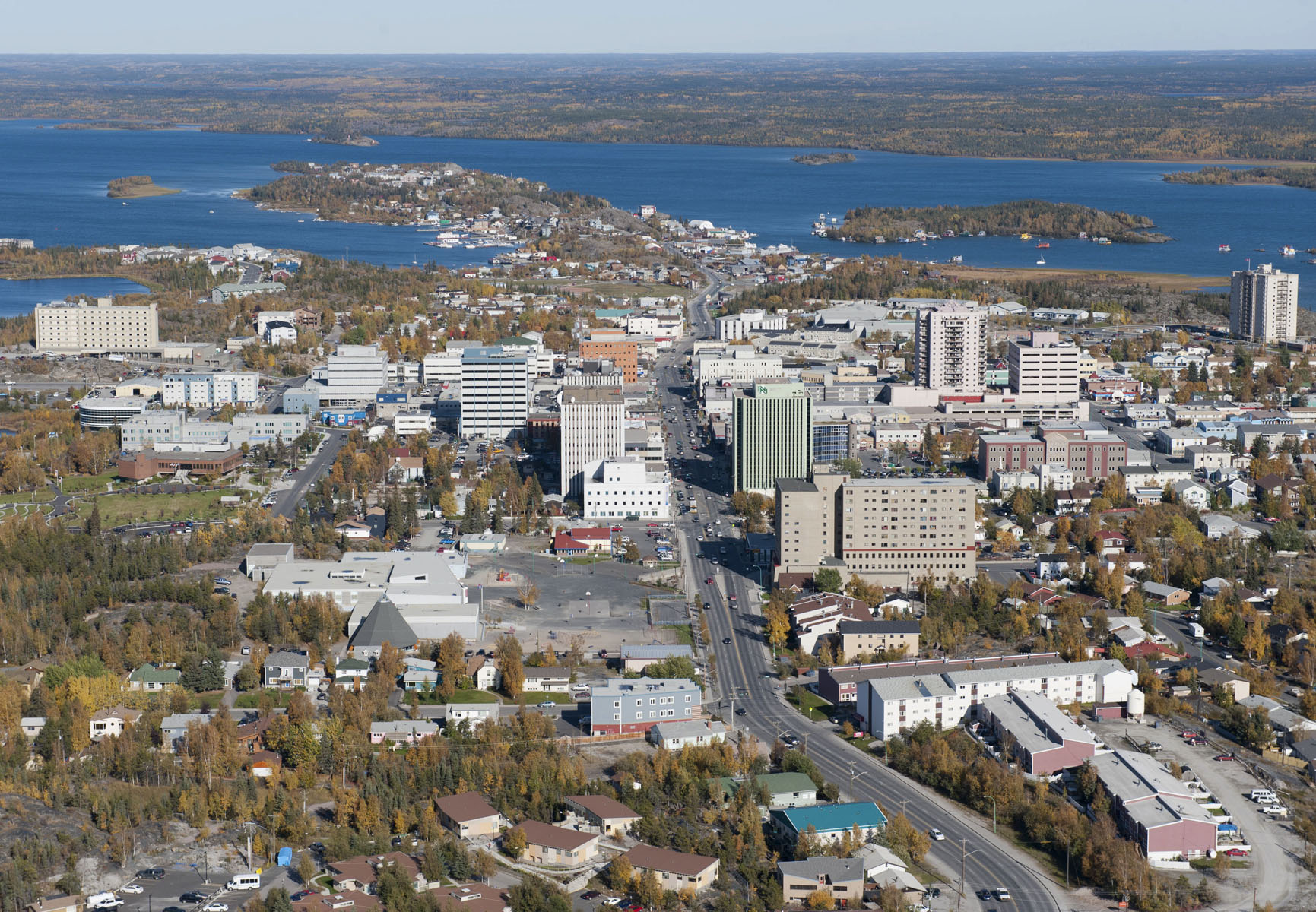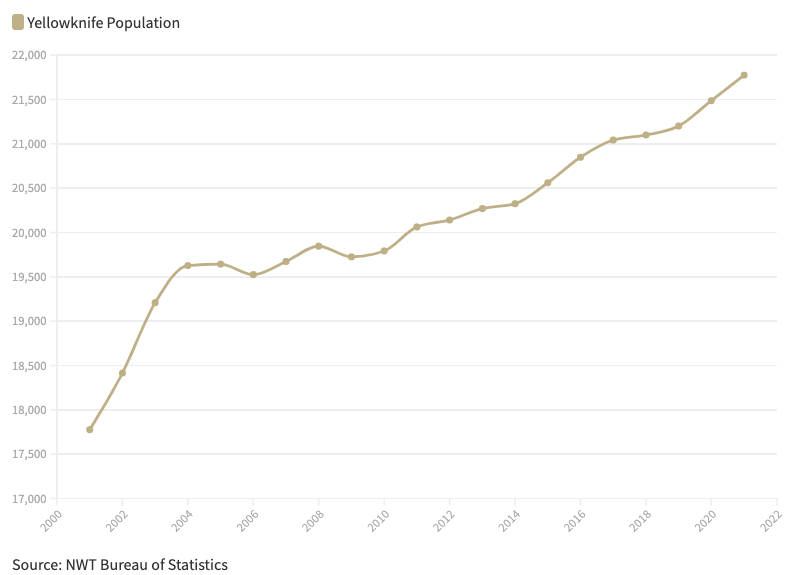Does Yellowknife Need a New Neighbourhood?
In my experience, when you ask Yellowknifers if they think our population is growing, shrinking, or staying the same, the majority of them believe it’s either staying the same or shrinking. I’m not sure why this is. It may have something to do with media reporting on the territory-wide population, which has been shrinking in recent years. Or it may be due to a lack of obvious sources of population growth, with diamond mines winding down and the pandemic hampering our tourism industry. But while the source of our population’s growth may be a bit of a mystery, we are in fact growing.
According to the NWT Bureau of Statistics, in 2021 Yellowknife’s population reached 21,775 people, which represents growth of 1.35% over 2020. While this is not exactly frenzied, Whitehorse-level growth, it is consistent and is enough to make a difference when it comes to demand for Yellowknife housing.
Over the last 20 years, our city has grown by an average of 1.03% per year, and there were only two years when it declined – 2006 and 2009. Statistics Canada tells us that we had 7,758 private dwellings in 2016. This means that our growth justifies the construction of 80 private dwellings per year.
So, what happens if we don’t hit this number in a given year? What if there is no land for sale in our city upon which new houses and apartment buildings can be built? Or what if the type of dwellings that are being built are not what the market is looking to buy? Well, in the next few years we are going to find out.
As I write this, there are only about a dozen lots for sale in Yellowknife – ten through the City of Yellowknife in the Hordal/Bagon neighbourhood and a couple others available privately or through Realtors. By the end of this year, it is likely that number will be down to zero. To be sure, not all the vacant lots that sold recently have houses on them yet, there are still quite a few larger homes to be built at Grace Lake South, but once these Grace Lake and Hordal/Bagon lots are built, that’s it – there are no new lots slated to come to market in the next four years (according to the 2020 Community Plan.)
What will come to market in the next four years is apartment units, and potentially a whole lot of them. There are several lots around town that are being prepared to accommodate the construction of apartment buildings, and we should see some of these projects get underway as soon as the snow melts. All told, we could see somewhere in the neighbourhood of 400 to 500 apartment units being built in the next four years.
But while this technically exceeds the 80-unit-per-year demand I mentioned earlier, what if the people who are looking for new homes are not looking for apartment units?
For people looking for larger formats of housing there are only so many options available. Some might purchase older homes, tear them down and build new ones. But this is a very expensive proposition. A downtown or near-downtown lot with an older home on it, and which is large enough to accommodate a 3-4 bedroom “stick-built” home with garage, plus room for a proper back yard sells for anywhere between $200,000 and $300,000. And then there are demolition costs to consider. This option simply isn’t realistic for most people, especially young families who haven’t yet built up the large amount of equity such a project requires. Yes, the option might exist to reduce costs by building two or more homes on a single lot, but that’s not what most people are looking for. They want single-family detached homes.
Some other folks will simply increase the amount they are willing to pay for a home that suits them and outcompete the many others looking for that same format of housing. That’s fine, but there can only be one winning family per house, which leaves a lot of other people with one other option – to stay in homes that don’t meet their needs as long as they can bear to, and then to move to a city or town with housing that better suits their needs.
What is unlikely to happen in my opinion, and what some folks reading this might be hoping for, is that folks who want a certain size and type of housing will simply change their minds and learn to love a smaller home, with no back yard or garage, in a more densely populated part of town. This type of social shift requires a lot of other factors that don’t exist North of 60. I’m not saying it never happens, but it’s pretty rare and should not be counted on as the solution to this problem. Sometimes you have to give people want they want, or you lose those people. And this is especially true in today’s world where workers are becoming more and more mobile.
When people leave Yellowknife in search of more suitable housing, many of them are quickly replaced by newcomers, because they leave job vacancies behind. While that’s fine for maintaining population levels, it’s obviously not good for community cohesiveness. People who commit to communities long term invest in those communities. They create businesses and jobs, they support causes, they give back in many other ways. And in the case of retirees, they provide all of these benefits plus they grow the net population and the tax base, bringing more dollars into territorial and municipal government coffers.
With each passing year there are more and more retirees looking to stay here, partly because of the sheer size of the baby boom demographic, but also because real estate prices in popular Canadian retirement destinations are skyrocketing relative to ours. The “snowbird” lifestyle is becoming a more attractive option, but without suitable housing, it is a difficult path to take. I have this conversation with retirees on a regular basis. Our current housing stock simply does not meet their needs.
All of this is a pretty long-winded way to make my point that Yellowknife needs to develop a new neighbourhood. In other cities this is something that could happen quickly, because increased demand would spur agricultural landowners at the outskirts of town to convert their lands to new residential lots. In those places it would be almost unheard of for the inventory of vacant lots to reach zero. But there is no such thing as “agricultural landowners at the outskirts of town” in the North. In Yellowknife, the City has to go hat in hand to the GNWT Department of Municipal and Community Affairs seeking bits and pieces of land for new development. Fortunately, City Council has taken a different approach this time – the hat is much bigger. They have asked for all lands within the municipal boundary and it seems that the folks at MACA have agreed. That’s great news, but it will take time. Even if lands are transferred within two years, it could take another two to bring them to market. And it will take even longer if this issue is not seen as a priority by future Councils and future Legislative Assemblies.
It’s difficult to quantify the missed opportunities that result from a mismatch between housing demand and housing supply, but it’s certainly something we should try to do. And if we keep the pressure up, perhaps we can nudge supply and demand into closer alignment in the not-too-distant future.







